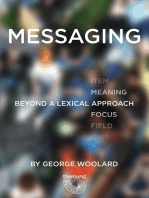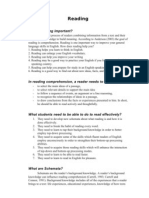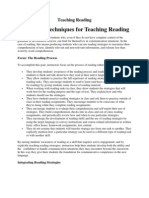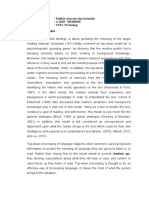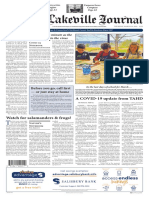Modul Reading Topic 2 TSL 3106
Modul Reading Topic 2 TSL 3106
Uploaded by
Rohayanti Binti YaakopCopyright:
Available Formats
Modul Reading Topic 2 TSL 3106
Modul Reading Topic 2 TSL 3106
Uploaded by
Rohayanti Binti YaakopOriginal Description:
Original Title
Copyright
Available Formats
Share this document
Did you find this document useful?
Is this content inappropriate?
Copyright:
Available Formats
Modul Reading Topic 2 TSL 3106
Modul Reading Topic 2 TSL 3106
Uploaded by
Rohayanti Binti YaakopCopyright:
Available Formats
TOPIC 2
THEORETICAL MODELS OF READING AND APPROACHES TO TEACH READING
SYNOPSIS Topic 2 provides you with an overview of the different models of reading , (bottomup, top-down and interactive reading models) and the approaches to teach reading. The reading models provide insights to the ways different readers approach reading. This topic also discusses various approaches to teach reading. LEARNING OUTCOMES By the end of this topic, you will be able to: define the meaning of the three theoretical models of reading distinguish the application of the three reading models identify the various approaches to teach reading.
FRAMEWORK OF TOPICS
THEORETICAL MODELS OF READING
BOTTOM-UP
Theoretical Models of Reading
TOP-DOWN
INTERACTIVE
According to the literature surrounding reading theory there are three primary models which readers use: bottom-up, top-down and interactive models of reading. These 1
models have been used to explain the cognitive processes that occur as readers interact with the text. These reading theories will be discussed in turn.
Bottom-up reading model The central idea of the bottom-up reading model is that reading is a process of decoding a series of written symbols into aural sounds. Meaning is then derived from the blending of sounds. The diagram below describes this process.
discriminating every letter
matching phonemes and graphemes
blending sounds
discriminating every letter
pronunciation
meaning
(Cambroune, 1979)
Using this model, readers process each leatter as it is encountered. The letters or graphemes are then matched to a phoneme of the language. The phonemes are then blended together to form words. Meaning is then derived at the end of the process. A typical reading programme that adopts this model is the phonics approach. Text processing is linear whereby the incoming data or information has to be received before the higher level mental stages can transform and recode the information. Schemata is hierarchically organised from the most specific at the bottom to the most general at the top. This model is also known as outside-in (Cambourne, 1979) or part-to-whole model.
Top-down reading model 2
In the top-down model, the reading process is a reverse of the bottom-up model. Here, reading is conceptually driven. Readers use their background knowledge to make predictions as they read the text. The following diagram illustrates this model of text processing.
past experience, language intuitions and expectations
selective aspects of print
meaning
sound, pronunciation if necessary
(Cambroune, 1979)
From this diagram, it can be seen that the model emphasises the reconstruction of meaning rather than the decoding of form. The interaction of the text is central to the process and the reader brings to this interaction his/her knowledge of the subject at hand, his/her knowledge and expectations about how language works, interest, motivation and attitude towards the subject or content of the text. In other words, the reader hypotheses or makes an assumption of the text and uses his/her background knowledge to confirm the hypothesis or assumption or reject the propositions. As with the bottom-up model, the top-down model also employs a linear text processing approach. This model is also known as inside-out model, concept-driven model and whole-topart model.
Exercise 1
What kind of readers are most likely to adopt the top-down reading approach? Why do you think so?
Exercise 2 In groups of 3, discuss how you use bottom-up reading approach for Year One pupils. Present your discussion in class.
Interactive reading model
The interactive model, like the top-down model, is also reader-driven. It views the reading process as an interaction between the reader and the text. Stanovich (1980) claims that readers process text, not by linear processing as advocated in the two earlier models, but by utilizing information provided simultaneously from several different sources, and that they can compensate for deficiencies at one level by drawing on knowledge at other levels. These sources include all those described in the two earlier models of text processing, that is phonological, lexical, syntactic, semantic and discourse knowledge. In other words, the interactive model views reading as a cyclical pattern whereby textual information and the readers mental activities occur simultaneously executing both top-down, bottom-up processing. When the reader employs the interactive model, he is seen as using his expectations and prior knowledge to guess the content of the text while contributing the bottom-up processing to ensure that new information is also utilized.
** A note to teachers With the insight that there is more to comprehension that the words on the page provides, these theoretical models help explain the way our background knowledge guides the comprehension process and the implications for second language reading. Eskey and Grabe (1988) suggested two general implications for ESL reading. First, that a strong, bottom-up foundation of basic identification skill is paramount. Second, reading for meaning, that is ultilising the top-down approach should also be well developed because reading is not just limited to decoding skills.
Approaches to teach reading 4
Reading ability is best developed in association with writing, listening and speaking activities. Even in those courses that may be labelled reading, your goals can be best achieved by capitalizing on the interrelationship of skills, especially the readingwriting connection. It is a mistake to rely on one approach to teach reading because a method that works for one child may not work at all for another. Good teachers have recognised that children learn in different ways and need different strategies. In this module you are introduced to three methods to teach reading. They are using sight word, language experience and phonics method.
Sight Word Approach Sight word acquisition is an important building block in the construction of a childs ability to read. What is sight word? Sight words are words that appear so often in a text that readers are able to read by sight without having to decode them. Sight words are also words that cannot be decoded and must be memorised by sight. Knowing these high frequency words and being able to recognise non-decodable words by sight are extremely important skills for reading fluency. In order to read well, children need to read sight words very quickly. Memorisation of sight words is necessary and few words at a time are highly recommended.
The objectives of teaching sight words are to: enable pupils to associate the appearance of each sight word with its sound/pronunciation (sight to sound correspondence) read sight words in context recognise sight words quickly and effortlessly. (rapid recognition)
Exercise 1 Based on your experience, what kind of practice can you do to achieve the above objectives? Work in your study group.
Language Experience Approach 5
Language experience approach is suitable for all levels of learners. By using the Language Experience Approach (LEA) to teach beginning readers how to read, pupils can connect their life experiences with learning written words. The unique factor about this approach is that the pupils own words are recorded or used as they describe the event or activity. This allows them to interact with the text and gain knowledge and understanding through their experience. The LEA can be used with individual pupils or group. While it is most commonly used with young emerging readers, it is also effective for teaching struggling readers.
Procedure to use the learning experience approach
1. Have the pupils choose an experience that they would like to write about. For groups, this should be a shared experience such as a field trip or an activity that the whole class had participated in. For individual pupils, it could be anything that the pupil feels is important or interesting, such as a family activity, a story about their pet or favorite toy, or even a television show or movie that they enjoyed. The language experience approach can also be used to create fictional stories.
2. Discuss the experience with the pupils. This helps them to clarify what they want to write about, organize their thoughts, and come up with specific, descriptive vocabulary.
3. Write the story down as the pupils dictate it. For groups, have pupils take turns dictating sentences describing their experience. Record what they say on large chart paper, repeating the words as they are written. For individual pupils, this can be done on a single sheet of paper, or it can be made into a book. The writing should be done in neat, large print rather than cursive, to make it easier for the pupils to read. Try to stick to the pupils' own words exactly as they are spoken with a minimum of correction for grammar or sentence structure. It is important for pupils to see their own words in print, because they have a personal connection to the words.
4. Read the text aloud. Point to each word as you read it aloud. After reading the text to the pupils, have them reread it aloud. With a group, call on individual pupils to 6
read sentences, or have them read chorally as a group while pointing to each word. Pupils can illustrate their individual texts and read them aloud to the class. Since the words that the pupils dictate are familiar and are used in a meaningful context, pupils will be able to read more difficult vocabulary than they might ordinarily be able to if they simply saw it printed in a book.
Phonics Approach An alphabetic, phonic approach to teaching reading has been used for centuries. In the 19th century, this kind of approach began to be called phonics. Since then it has been further developed and modified. Today a phonics approach is used in varying degrees in most reading instructions. This approach has been included in the KSSR syllabus. A phonics approach teaches the relation of the letters (graphemes) to the sounds (phonemes) they represent. The theory behind the phonics approach is based on two assumptions: most languages have consistent phonemes (sound) to grapheme (letter) corelation. Once children have learned the relationships of the letters to the sounds, they can pronounce printed words by blending the sounds together. Knowing these relationships helps early readers recognize familiar words accurately and automatically and "decode" new words. Though this approach has been well received, there are some grey areas which makes it not a complete model or a stand alone approach to teach early reading. For instance, a child can use phonics to work out that b-a-t means bat because the letters represent their most common sounds; but phonics is of no help in reading eye as there is no correspondence between the letters and the sounds the letters represent. Furthermore, English has its many irregularities, therefore it makes it harder for ESL learners to identify unfamiliar words. The use of phonics assumes that once readers know how a word is pronounced, they will associate it with a spoken word they already know and therefore understands it. However, the problem may arise especially with intermediate pupils who may come upon a new word which they have not heard of. So working out how a word might be pronounced is not going to guarantee understanding.
Phonics may be useful and helpful at the initial stages of developing reading but it needs to be supported by other methods as the readers reading proficiency develops. Exercise 3 7
Systematic and explicit phonics instruction significantly improves kindergarten and first grade children's word recognition and spelling.
Do you agree with the quote above. Justify your answer.
References
Cambourne, B. 1979. How important is theory to the reading teacher? Australian Journal of Reading, 2: 78-90 Eskey, D.E. & Grabe, W. 1988. Interactive Models for Second Language Reading: Perspectives on Instruction. In P. Carrell, J. Devine & D. Eskey. (Eds.), Interactive approaches to second language reading (pp. 223-38). New York: Cambridge University Press. Stanovich, K. 1980. Toward an interactive-compensatory model of individual differences in the development of reading fluency. Reading Research Quarterly, 16:32-71.
You might also like
- Messaging: beyond a lexical approach in ELTFrom EverandMessaging: beyond a lexical approach in ELTRating: 5 out of 5 stars5/5 (1)
- Developing Reading Skills - Seminar PaperDocument5 pagesDeveloping Reading Skills - Seminar Paperyellow submarina100% (1)
- Fifty Ways to Teach Reading: Fifty Ways to Teach: Tips for ESL/EFL TeachersFrom EverandFifty Ways to Teach Reading: Fifty Ways to Teach: Tips for ESL/EFL TeachersRating: 4 out of 5 stars4/5 (3)
- The Four Phases of Language PlanningDocument2 pagesThe Four Phases of Language PlanningRonalyn Clor100% (5)
- Different Approaches To Teaching ReadingDocument19 pagesDifferent Approaches To Teaching ReadingJasper Villaflor Paulite67% (3)
- A Study On Consumer Preferance Towards Sony Television in TirupurDocument69 pagesA Study On Consumer Preferance Towards Sony Television in Tirupurselvi abraham100% (1)
- Internship PlanDocument4 pagesInternship PlanLindsay Watson100% (1)
- Topic 2 Theoretical Models of Reading and Approaches To Teach ReadingDocument8 pagesTopic 2 Theoretical Models of Reading and Approaches To Teach ReadingAnis Fadzilah ZulkifleNo ratings yet
- Language Teaching Appreciation: Reading Approaches and StrategiesDocument4 pagesLanguage Teaching Appreciation: Reading Approaches and StrategiesFheil Karl FailmaNo ratings yet
- EDR Midterm Exam - JMCabelloDocument5 pagesEDR Midterm Exam - JMCabellojesson cabelloNo ratings yet
- Analytical PhonicsDocument6 pagesAnalytical PhonicsI-Reen FrancisquiteNo ratings yet
- How To Improve Reading Comprehension SkillsDocument8 pagesHow To Improve Reading Comprehension SkillsRsksamyNo ratings yet
- Pre-Final LessonsDocument51 pagesPre-Final LessonsJules Cris-Ann LumbaoNo ratings yet
- Teaching ReadingDocument12 pagesTeaching ReadingDado Dodo100% (1)
- How To Teach Grammar 1Document28 pagesHow To Teach Grammar 1Anis Fadzilah ZulkifleNo ratings yet
- TEFL SSummaryDocument4 pagesTEFL SSummarymariaNo ratings yet
- Module 7english Language Arts ReportDocument67 pagesModule 7english Language Arts ReportJERVOSO, DANJIE R.No ratings yet
- Goodbye Round RobinDocument2 pagesGoodbye Round Robinapi-252219561No ratings yet
- M6 Grammar and PronunciationDocument4 pagesM6 Grammar and PronunciationHải Trà NguyễnNo ratings yet
- Council of Europe, Communication in The Modern Language Classroom, by Joe Sheils, 1993Document11 pagesCouncil of Europe, Communication in The Modern Language Classroom, by Joe Sheils, 1993marivoskanyan63No ratings yet
- 1Document54 pages1Maria Francessa AbatNo ratings yet
- Finals Module Teaching English in The ElemDocument55 pagesFinals Module Teaching English in The ElemHaifa dulayNo ratings yet
- Educ2631 ExaminationDocument10 pagesEduc2631 Examinationapi-458955453No ratings yet
- The Importance of ReadingDocument39 pagesThe Importance of ReadingyousufbaiNo ratings yet
- Reading SkillsDocument34 pagesReading Skillsvenus97zuhreNo ratings yet
- Makalah NewDocument11 pagesMakalah NewAnida Riyanti50% (2)
- Methods of Teaching Grammar - CompilationDocument8 pagesMethods of Teaching Grammar - CompilationUrsua KlinelleNo ratings yet
- The Schema TheoryDocument3 pagesThe Schema TheoryHarukaNiLauNo ratings yet
- What Is The Difference Between Intensive and Extensive ReadingDocument11 pagesWhat Is The Difference Between Intensive and Extensive ReadingWan Amir Iskandar Ismadi100% (2)
- Reading Microskills and Procedure For Training ThemDocument11 pagesReading Microskills and Procedure For Training ThemtrinhquangcoNo ratings yet
- Teaching Material Development: Disusun OlehDocument10 pagesTeaching Material Development: Disusun OlehdewiNo ratings yet
- Teaching Reading and WritingDocument33 pagesTeaching Reading and WritingJESSICA ROSETE50% (2)
- TEACHING - READING - The Nature of ReadingDocument22 pagesTEACHING - READING - The Nature of ReadingManuel Arlindo JaimeNo ratings yet
- TEMA - 3 Oposiciones de PrimariaDocument12 pagesTEMA - 3 Oposiciones de PrimariaAnxosPereiraSegundoNo ratings yet
- M2 FormativeEssay AMDocument4 pagesM2 FormativeEssay AMabd.1999.allahNo ratings yet
- Theories of ReadingDocument3 pagesTheories of ReadingJenny Mae Mejorada PelpinosasNo ratings yet
- Introducing Positive Psychology To Second Language Acquisition (SLA)Document18 pagesIntroducing Positive Psychology To Second Language Acquisition (SLA)Елизавета КовалёваNo ratings yet
- Thesis Reading SkillsDocument7 pagesThesis Reading SkillsApaPapersForSaleUK100% (1)
- 5 Ways To Support Students Who Struggle With Reading ComprehensionDocument4 pages5 Ways To Support Students Who Struggle With Reading ComprehensionJherick TacderasNo ratings yet
- Grammar DictationDocument9 pagesGrammar DictationlirutNo ratings yet
- ReadingDocument2 pagesReadingRia Kumala Dewi100% (1)
- INTRODUCTIONDocument12 pagesINTRODUCTIONAstenaLargamaNo ratings yet
- Teaching ReadingDocument3 pagesTeaching ReadingNguyen Van TuyenNo ratings yet
- React 2002 2 133Document9 pagesReact 2002 2 133al286359No ratings yet
- How Do You Teach Reading ComprehensionDocument10 pagesHow Do You Teach Reading ComprehensionMadz AñanoNo ratings yet
- Reading ApproachDocument7 pagesReading Approachangelito peraNo ratings yet
- ESOL Strategies Matrix A. Listening A1. LEA (Language Experience Approach)Document17 pagesESOL Strategies Matrix A. Listening A1. LEA (Language Experience Approach)attar8No ratings yet
- A Psycholinguistic Account of Reading: Create By: Fimel Rospintar Iman LarosaDocument9 pagesA Psycholinguistic Account of Reading: Create By: Fimel Rospintar Iman LarosaFimelNo ratings yet
- .Teaching Reading. TeflDocument7 pages.Teaching Reading. TeflROFILAHSALSABILANo ratings yet
- Teaching ReadingDocument5 pagesTeaching ReadingRembulan Onaa Unny100% (1)
- Schema Theory and Reading ComprehensionDocument10 pagesSchema Theory and Reading ComprehensionSiti Norshahila100% (3)
- Jurnal NHTDocument22 pagesJurnal NHTEdi Jonet OtoluwaNo ratings yet
- Methods of Learning and Teaching Lexis 2Document38 pagesMethods of Learning and Teaching Lexis 2Kate GordanNo ratings yet
- Enseñanza Ii Primer ParcialDocument7 pagesEnseñanza Ii Primer ParcialRaquel GonzalezNo ratings yet
- Whole LanguageDocument3 pagesWhole LanguagegorkitorcazaNo ratings yet
- Extensive Reading DoneDocument7 pagesExtensive Reading Donesuci apriliana pertiwiNo ratings yet
- Teaching EFL ReadingDocument6 pagesTeaching EFL Readingmanalmanila780No ratings yet
- Literacy Stategies RepairedDocument58 pagesLiteracy Stategies Repairedapi-295570382No ratings yet
- Unit 3 Reading SkillsDocument18 pagesUnit 3 Reading SkillsAPURV CHOUBEYNo ratings yet
- BCNC ReadingDocument10 pagesBCNC Readingapi-303081767No ratings yet
- Group 7 PresentationDocument49 pagesGroup 7 PresentationJERVOSO, DANJIE R.No ratings yet
- Interacting with Informational Text for Close and Critical ReadingFrom EverandInteracting with Informational Text for Close and Critical ReadingNo ratings yet
- 25 Dutch Reading Comprehensions for Beginners: Book One: Dutch Reading Comprehension TextsFrom Everand25 Dutch Reading Comprehensions for Beginners: Book One: Dutch Reading Comprehension TextsNo ratings yet
- Year 5 Unit 1 Family Day LPDocument6 pagesYear 5 Unit 1 Family Day LPRohayanti Binti Yaakop100% (1)
- LGA3101 Children - S Literature TOPIC 9 & 10 Sem 3Document38 pagesLGA3101 Children - S Literature TOPIC 9 & 10 Sem 3Rohayanti Binti YaakopNo ratings yet
- Words Given Phonetics Symbol: A B C D eDocument1 pageWords Given Phonetics Symbol: A B C D eRohayanti Binti YaakopNo ratings yet
- Phoneme I ReadingDocument15 pagesPhoneme I ReadingRohayanti Binti YaakopNo ratings yet
- TSL 3107 Writing Exam Revision QuestionsDocument8 pagesTSL 3107 Writing Exam Revision QuestionsRohayanti Binti YaakopNo ratings yet
- Instrumen Pentaksiran Standard Prestasi Bahasa Inggeris Tahun 1Document62 pagesInstrumen Pentaksiran Standard Prestasi Bahasa Inggeris Tahun 1Rohayanti Binti YaakopNo ratings yet
- Lesson Plan KSSR Tahun 3 Listening and SpeakingDocument1 pageLesson Plan KSSR Tahun 3 Listening and SpeakingJoni ArnoldfNo ratings yet
- Information Processing ModelDocument17 pagesInformation Processing ModelRohayanti Binti YaakopNo ratings yet
- Lecture 6 - Notes-1Document20 pagesLecture 6 - Notes-1Benedicta Kyei BaffourNo ratings yet
- Comprehensive Guidance PlanDocument4 pagesComprehensive Guidance Planapi-374283780No ratings yet
- ENGLISH-10 Q1 Mod1 Overcoming-ChallengesDocument14 pagesENGLISH-10 Q1 Mod1 Overcoming-ChallengesFrancesca Shamelle Belicano RagasaNo ratings yet
- The Lakeville Journal - March 19, 2020Document10 pagesThe Lakeville Journal - March 19, 2020Lakeville JournalNo ratings yet
- Concrete Pictorial Abstract Approach On Students Attitude and Performance in MathematicsDocument23 pagesConcrete Pictorial Abstract Approach On Students Attitude and Performance in MathematicsArifudin SuryaNo ratings yet
- Introduction: A Rough Guide To Cognitive LinguisticsDocument1 pageIntroduction: A Rough Guide To Cognitive LinguisticsArul DayanandNo ratings yet
- Consulting 101 - Driving Strategic ImpactDocument7 pagesConsulting 101 - Driving Strategic ImpactsatyabratmNo ratings yet
- Colin Mcfarlane. Assemblage and Critical Urbanism. 2011Document22 pagesColin Mcfarlane. Assemblage and Critical Urbanism. 2011Marcos Burgos100% (1)
- Chapter8tourismpromotion 130326220344 Phpapp02Document21 pagesChapter8tourismpromotion 130326220344 Phpapp02Tonya MerrittNo ratings yet
- Sri Ram Application-FormDocument3 pagesSri Ram Application-FormRagini BajpaiNo ratings yet
- Action Plan As Grade Level ChairmanDocument2 pagesAction Plan As Grade Level ChairmanRachelle Ann88% (8)
- Rpms Template 101Document17 pagesRpms Template 101donna kristine DelgadoNo ratings yet
- International Journal of Multidisciplinary: Applied Business and Education ResearchDocument9 pagesInternational Journal of Multidisciplinary: Applied Business and Education Researchhmkjhyf6qhNo ratings yet
- Result of H S Level Examination B Block 2021Document94 pagesResult of H S Level Examination B Block 2021debajith2020No ratings yet
- Paragraph WritingDocument21 pagesParagraph WritingSyed Mustafa100% (1)
- Confimation LetterDocument2 pagesConfimation Lettermark kimNo ratings yet
- Subject-Verb Agreement RulesDocument16 pagesSubject-Verb Agreement Rulesyeniffer espinozaNo ratings yet
- Final Project Question COEB422 Project Sem 1 2016 - 17Document5 pagesFinal Project Question COEB422 Project Sem 1 2016 - 17Elyas Mohammed100% (1)
- Unec 1666678417Document7 pagesUnec 1666678417Şəbnəm HacızadəNo ratings yet
- Book List With Pricing - 22.8.19 - Phoenix - Sort by Book Category PDFDocument199 pagesBook List With Pricing - 22.8.19 - Phoenix - Sort by Book Category PDFPyae Sone Kyaw100% (1)
- Aman Kumar: Project CertificateDocument1 pageAman Kumar: Project CertificateAman KumarNo ratings yet
- AC-listDocument32 pagesAC-listArvin Dabas100% (1)
- Vanlalhmingmawia Fanai Attendance Semester 3Document1 pageVanlalhmingmawia Fanai Attendance Semester 3Vanlalhmingmawia FanaiNo ratings yet
- Civics and Ethical Education - Grade 9 Student TextbookDocument30 pagesCivics and Ethical Education - Grade 9 Student TextbookDaniel AlemuNo ratings yet
- The 30 Second Mobility CureDocument8 pagesThe 30 Second Mobility Curesteppenwolf88No ratings yet
- 5054 w09 Ms 2Document6 pages5054 w09 Ms 2mstudy123456No ratings yet
- Islam and Modernity PDFDocument305 pagesIslam and Modernity PDFشهرول عفيفيNo ratings yet
